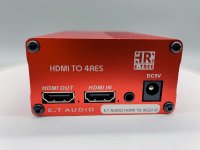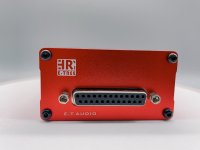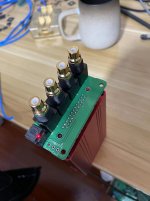Aww come on HDCP is a pain in the *** just like proprietary connectors.I would be wary of ascribing such petty motivations to others.
That has nothing to do with SDI or its originators and there is more to HDMI than HDCP. You are always free to come up with your own offering.
If you need HDCP keys, you can use ADV7612BSWZ or ADV7612WBSWZ. I don't care about the video but only need to get the audio signal from it. The video output has another HDMI 1TO 2 chip to achieve distribution output.
You can't buy chips with keys around here with being a HDCP license holder.If you need HDCP keys, you can use ADV7612BSWZ or ADV7612WBSWZ.
If I have this right, the ADV7612 extracting the audio never actually connects to another device, HDCP compliant or not, so there is no HDCP negotiation.I don't care about the video but only need to get the audio signal from it. The video output has another HDMI 1TO 2 chip to achieve distribution output.
I see the ADV7612BSWZ-P can only do HDMI 1.4a does your loop out HDMI port support HDMI 2.0 or are you limited to the 1.4a from the chip?
Whether the loop-out supports HDMI2.0 depends on the distribution chip. The loop-out I use supports HDMI1.4b. This is also determined by the distribution chip and has nothing to do with ADV7612BSWZ-P.
@yulen
Please could you precise the format of the HDMI your box could deal with ? The ATV 4K is presently HDMI 2.0 and it's possible to output 6 LPCM audio streams.
Did you modifying the audio streams in any way, like the gain for example ? Do you plan to implement some functions like the output levels of each audio stream ?
Are you processing or taken into account the jitter induced by HDMI format ? Some info on this possible issue is very interesting.
Thanks for your precisions !
Please could you precise the format of the HDMI your box could deal with ? The ATV 4K is presently HDMI 2.0 and it's possible to output 6 LPCM audio streams.
Did you modifying the audio streams in any way, like the gain for example ? Do you plan to implement some functions like the output levels of each audio stream ?
Are you processing or taken into account the jitter induced by HDMI format ? Some info on this possible issue is very interesting.
Thanks for your precisions !
@ondesx
My box is mainly used to de-embed the audio signal in the HDMI signal (separate the audio signal from the HDMI signal), so in addition to lpcm, DOLBY, DTS, and DSD can be separated, but AES/EBU generally transmits PCM format data , so it is recommended that the audio stream in HDMI must be in LPCM format. Of course, it can also be in dolby or dts format, but in this case a corresponding decoder is required to decode it. My red box supports up to LPCM7.1 (8-channel audio stream). There is no special treatment for the jitter problem. The HDMI de-embedding chip serves as the I2S host, and the other interface chips serve as the I2S slaves, with a clock buffer in the middle
My box is mainly used to de-embed the audio signal in the HDMI signal (separate the audio signal from the HDMI signal), so in addition to lpcm, DOLBY, DTS, and DSD can be separated, but AES/EBU generally transmits PCM format data , so it is recommended that the audio stream in HDMI must be in LPCM format. Of course, it can also be in dolby or dts format, but in this case a corresponding decoder is required to decode it. My red box supports up to LPCM7.1 (8-channel audio stream). There is no special treatment for the jitter problem. The HDMI de-embedding chip serves as the I2S host, and the other interface chips serve as the I2S slaves, with a clock buffer in the middle
There is a DSP expansion interface socket inside the red box. You can use this interface to expand DSP functions (existing DSP cards are ADAU1701, ADAU1445), such as gain adjustment. If no DSP expansion card is added, the I2S audio de-embedded by HDMI will be directly converted to AES/EBU output.@yulen
Did you modifying the audio streams in any way, like the gain for example ? Do you plan to implement some functions like the output levels of each audio stream ?
Here I will briefly introduce the interface and functions of the HDMI red box:
It has the following interfaces:
1. One HDMI input, one HDMI output, the output supports up to 4K@30hZ (supports HDMI1.4b)
2. One DB25 female interface output, including 4 sets of aes/ebu output, one set of spdif output, and one set of UART interface
3. A 3.5mm infrared expansion interface to expand the infrared remote control receiving function
4. A 5V/2A power interface
5. It has an internal DSP expansion interface, which can expand various functions through DSP cards.
It has the following functions:
1. The DB25 interface can achieve 4 sets of coaxial output or 4 sets of optical fiber output through expansion cards under the default 4*AES/EBU output.
2. The spdif interface on DB25 is the loopout of i2s0 (that is, AES0)
3. The UART interface is mainly used to realize the remote control function of Dolby CP750 or Dolby CP650, and realize the volume control, volume muting, sound source selection and other functions of the device. This function must be used with infrared reception, otherwise it cannot be controlled by the remote control.
4. Audio stream output supports up to 96k/24bit
5. The internal DSP expansion interface can currently be expanded to adau1701 or ADAU1445, and users can also expand by themselves.




It has the following interfaces:
1. One HDMI input, one HDMI output, the output supports up to 4K@30hZ (supports HDMI1.4b)
2. One DB25 female interface output, including 4 sets of aes/ebu output, one set of spdif output, and one set of UART interface
3. A 3.5mm infrared expansion interface to expand the infrared remote control receiving function
4. A 5V/2A power interface
5. It has an internal DSP expansion interface, which can expand various functions through DSP cards.
It has the following functions:
1. The DB25 interface can achieve 4 sets of coaxial output or 4 sets of optical fiber output through expansion cards under the default 4*AES/EBU output.
2. The spdif interface on DB25 is the loopout of i2s0 (that is, AES0)
3. The UART interface is mainly used to realize the remote control function of Dolby CP750 or Dolby CP650, and realize the volume control, volume muting, sound source selection and other functions of the device. This function must be used with infrared reception, otherwise it cannot be controlled by the remote control.
4. Audio stream output supports up to 96k/24bit
5. The internal DSP expansion interface can currently be expanded to adau1701 or ADAU1445, and users can also expand by themselves.
Attachments
@enser
The red box has been discontinued and is no longer for sale. The replacement product is the black box.
The red box has been discontinued and is no longer for sale. The replacement product is the black box.
Attachments
- Home
- Source & Line
- Digital Line Level
- HDMI to AES/EBU


